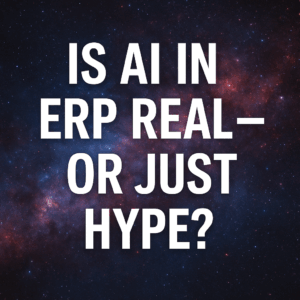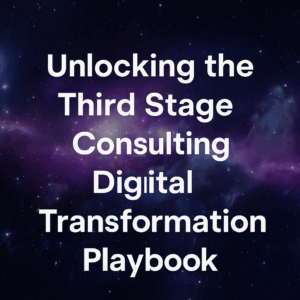Organizational change management is the number one thing you can do to make your ERP implementation or digital transformation successful. With it, you have a chance to succeed and without it, you have limited to no chance to succeed.
Today I will offer five steps to optimize your organizational change management strategy for success, and overcome the people issues that most digital transformations face.
Now in all of our years as expert witnesses, project recovery, and greenfield implementation experts, my team and I have found that we have yet to meet a single CIO, CEO, or CFO or any executive/project team member who has indicated that they allocated too many resources to organizational change. In fact, I don’t recall a single situation where a team member or an executive said we spent enough time, money, and effort on organizational change.
Table of Contents
ToggleThe Importance of Change Management
Change management is clearly the number one thing that will determine whether or not your project succeeds or fails. This is a really important point because if we look at the today’s landscape in the ERP space, were focused way too much on technology. Things like artificial intelligence, machine learning, and ERP cloud products… all this cool stuff that has to do with technology, but is really insignificant to the core business.

The most important thing is, how well your people adapt to the digital transformation and the technological capabilities that you’re trying to deploy throughout your organization. The significance of change management is especially true if you and your team are interested in deploying software best practices and limiting customization of the software. It’s also especially true if you are looking to implement a single ERP system across most of the enterprise.
The reason that these two details are critical to organizational change management is because it indicates that there’s going to be a greater impact and change throughout the entire organization – not siloed to one area of the business. If you don’t change the software to fit the business you need to adopt best practices or new processes and roll them down to your people.
If we’re deploying ERP across the entire enterprise a single system for multiple functions, departments, and international business locations, then organizational change management is going to be even more important than if we had done more of a “best of breed” approach to finding the best functional software for each of our departments.
Now, without further ado, let’s talk about the five steps that you can deploy to your organization to jumpstart your change management activities.
1. Organizational Readiness Assessment
The first thing is to implement or to conduct an organizational readiness assessment. This is a way to understand how resistant people will be to change, not if they’re resistant but how resistant they can be. It is important to understand how resistant people will be to change and what the root causes of that resistance will be.
If you’re a global organization with 20 – 30 different countries of operation, chances are you’re going to have somewhat of a heatmap result in terms of how resistant certain groups are versus how accepting of change other groups might be.
Now on the surface, some of you may be saying, well we don’t need to do that because our people are ready for change our old systems are so outdated that we know we need some sort of change and employees are on board with that. That’s great on the surface they may be on board, but the problem becomes when we dig down and actually start to talk about the nuts and bolts of how people are going to change – perceptions may change.
It’s pivotal to understand and appreciate that resistance to change is a very real thing. It may not be manifesting itself yet early in your project. People are excited about new technology and tired of old or broken technology within manual business processes. Again, this enthusiasm is excellent and should be celebrated. However, you want to be prepared to overcome that resistance in order to mitigate any business disruption that may impact the overall success of your project.

An organizational readiness assessment is step one in recognizing what’s unique to your organization and how are different departments/locations throughout the world are going to impact their level of resistance. Let’s take a look at how we do this. My team and I at Third Stage start with two tactics:
- An online survey, which will uncover some of those root causes of resistance in a quantitative way.
- A series of focus groups, which will gather qualitative sources of resistance to augment the quantitative analysis that we do in the online surveys.
These are two relatively easy ways to find out where those pockets of resistance are going to manifest.
2. Change Impact Assessment
The second thing is change impact assessment. It is a different look from organizational readiness. With this tool, we’re looking more specifically at different departments and functional areas. The goal is to garner an understanding of how exactly jobs and roles/responsibilities are going to change. Change impacts need to be understood in a pretty granular level detail in order to build a successful OCM strategy.
The change impact assessment is essential. And one word of warning here is a lot of times when you’re working with system integrators or the software vendors they’ll want to focus too much time on the future state. The future state is crucial don’t get me wrong, but we don’t want to gloss over and minimize the current state, because the current state is the people’s current reality. While the system integrators and vendors are defining what that feature state looks like, it’s the change management team’s responsibility to figure out here’s where we are and here’s what that impact is going to be.
Now let me remind you that we’re not yet talking about transactional training and getting into the system. We’re talking at a higher strategic level of understanding where we’re going to shift roles, responsibilities, jobs, and work throughout the organization. Generally, that’s something that needs outlining early in an implementation, usually during the blueprint of the design stage of a project.

Change impact assessment is hugely important but I would not leave that to your system integrator to execute. Why? Typically, they’re not thinking about your current state and they probably don’t care a lot about your future vs. current state because. Their job is to get the technology implemented. However, in order to be successful – you do need it from a change management perspective.
3. Alignment
Step number three, ensure that your team is aligned. I cannot stress the importance of this step enough. As an organization, you need to make sure that you’re aligned regarding the business objectives of a digital transformation or ERP project.
Now once we’ve done the change impact, we start to realize how big the impacts are going to be to the organization. We’ve also conducted the organizational readiness assessment at this point, so we understand where the pockets of resistance are likely to come from.
You must make sure to be aligned around what it is we’re going to do to tackle regarding those sources of resistance and those change impacts. Even more fundamentally, it is important to make sure we’re all on the same page with what the digital transformation is going to be. Ask yourself, is this a simple technology upgrade or is this a true business transformation.
Those are two very different scenarios, with very distinctive implementation strategies, resourcing needs, price tags, and pain tolerances. All executives and project stakeholders need to be on the same page.
Executives and leadership need to understand what sorts of change impact are possible, and are realistically aligned around the expectations of what it’s going to take to get our people to meet our objectives for the overall transformation.
Ensuring that internal alignment from the executive level down to mid-level management (at the very least) and all your key stakeholders at the senior level within the organization is absolutely key to achieving project success. .
4. Develop and Assemble your Change Team
The fourth term is to cultivate or to assemble your change team. Now, this should be primarily your internal team, your resources, your project team members, stakeholders, and change agents. Those should be primarily internal people. You can lean on outside resources, ideally technology-agnostic experts like Third Stage.
This should not be your system integrator.
Your system integrator is very good in general at implementing software they’re good at designing it, implementing it, and showing you how to use it. Their primary goal is to help you understand how the technology can enable better processes. That’s the sort of thing your system integrator, VAR, or vendor can support.
Make sure you have a separate team advising your internal team on how to best effect change. In my experience, one of the best approaches is a Trojan horse methodology to change management. You don’t necessarily have a big standalone change management team, but you have an individual change management team internally but a skinny-down version. It is important to make change management part of your DNA throughout the entire project. In other words, everyone on the project has some level of change management responsibilities.

What ends up happening is when times get tough, the pressure heightens, and budgets are getting cut – change management ends up being the first thing to go. This is a monumental mistake and often leads to project failure.
Ultimately, companies want to share that responsibility and use that hybrid approach to ensure that they’re deploying their change management responsibilities. Just be sure you identify those internal and external resources that you need for your change team.
5. Create your Change Strategy
The fifth and final step is to create your change strategy. Too many times companies will go in or even consultants will deploy a canned, out-of-the-box, off-the-shelf type of change strategy. This is not an effective way to manage change.
Organizations need to take steps one through four as prerequisites and inputs into helping us understand how we’re going to execute change given our unique situation, project objectives, people, culture, etc. You want to make sure that you create a change strategy a plan, tools, methodologies that are unique to you and your business.
It’s important to recognize that change management goes so far beyond basic training and communications. Too many companies think of change in the context of training and basic email about the product status. That is not change management. Updates and trainings is a tiny sliver of what effective change management constitutes.
Resources
If you want to find out more about organizational change management, download our OCM report here. This report includes a number of best practices around organizational change management and other implementation best practices based on our experience from over a thousand different digital transformations and ERP projects over the recent years.
I hope you find this information useful. If you’re a change management practitioner or someone who’s struggling with change management, I’d love to hear from you. I’m always happy to be an informal sounding board for you and your team.






